Dudleys have been building granaries on the Montana farm for at least 90 years. Without the oldest ones owls wouldn’t exist on the farm.
Veteran followers of Feathered Photography may have already seen many of these photos, though not all of them. But this time I’m providing much more context.
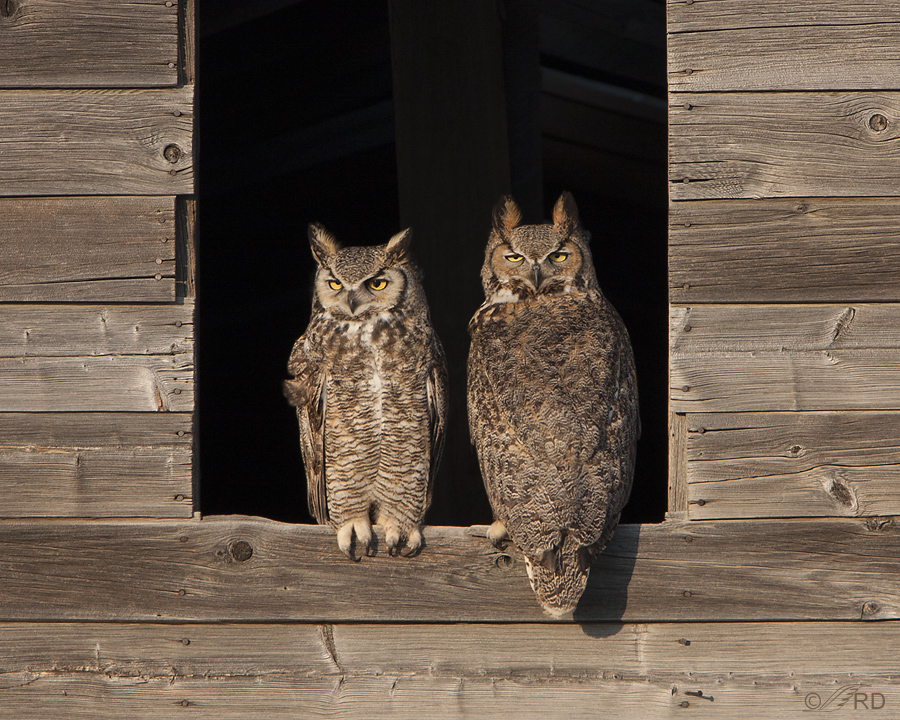
There were no owls on the farm when I was growing up there as a kid. But as the years passed the two adjacent Dudley farms (owned by my family and my uncle’s family) were incorporated into a single farm. Eventually far fewer people were living out there so Great Horned Owls found the old granaries to be inviting places to live and raise their families. They’ve now been there for decades.
The older granaries were built by my grandfather beginning in 1929-30 with help from his two sons, my Dad and my uncle..Dad and uncle Floyd eventually bought the farm and split it between them and began building their own granaries in the early 1940’s. As older granaries were largely abandoned and new ones built owls began to live in the older ones. And they’re still there.
This is a mated pair of adults in one of the auger cutouts of what we always called “the big granary”. The smaller male is on the left.
In the early summer fledged chicks are often found exploring the base of some of the old granaries. These little guys really get around – you never know where one or more of them will turn up, especially in the early morning.
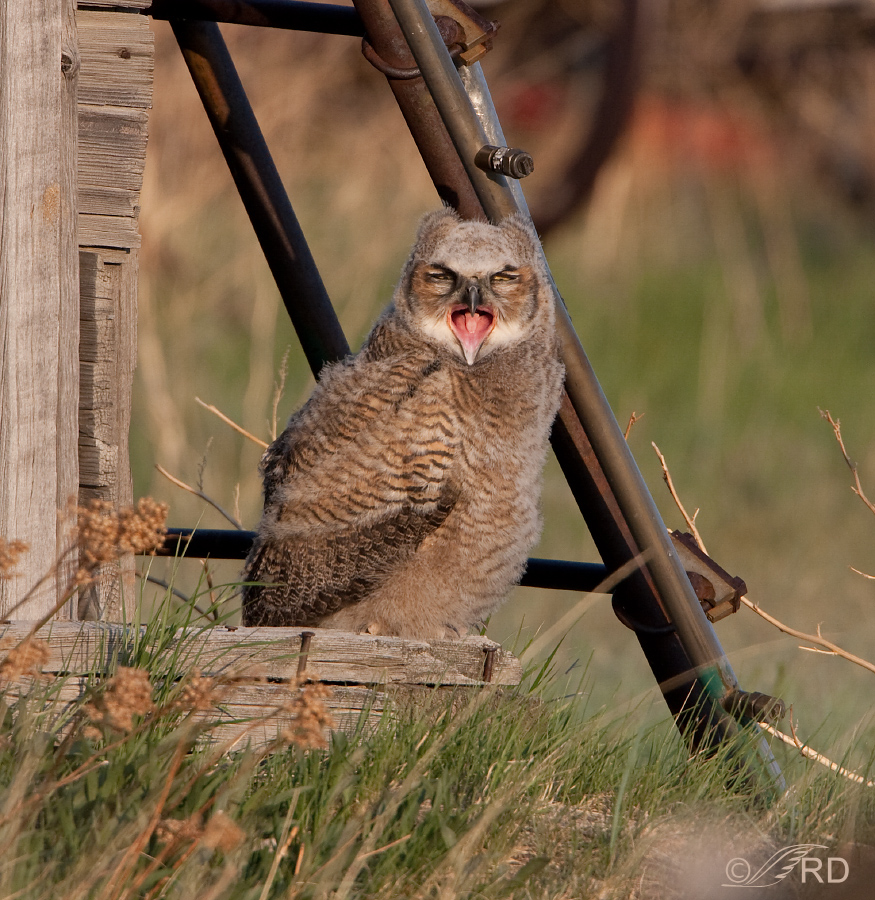
Here’s a slightly older fledged chick at the base of one of the granaries. This may look like a threat posture but it’s only a yawn.
This auger cutout is one of their favorite morning perches because it faces south and away from the hubbub often associated with the rest of the farm buildings.
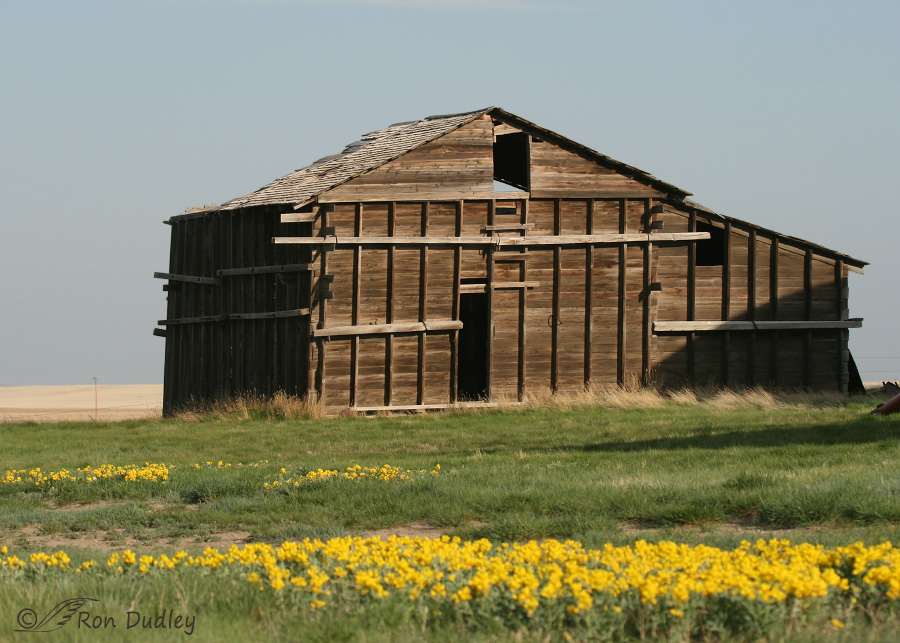
The owls loved this old granary but it was on top of a hill and the fierce Montana winds eventually blew it down.
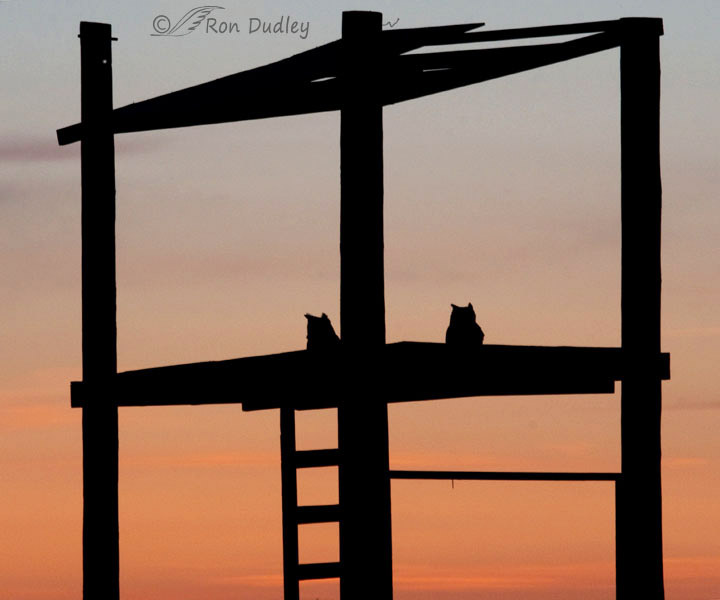
When old granaries eventually became too decrepit even for the owls to feel comfortable in the lumber in them was often recycled. This is a kid’s fort under construction that was partially built using recycled lumber from one of the old granaries. Owls like to perch on it at sunset.
I’ll bet even owls enjoy the colorful view of Glacier National Park to the west. If I’d aimed my camera a little lower we may have been able to see the iconic Chief Mountain in the far off distance.
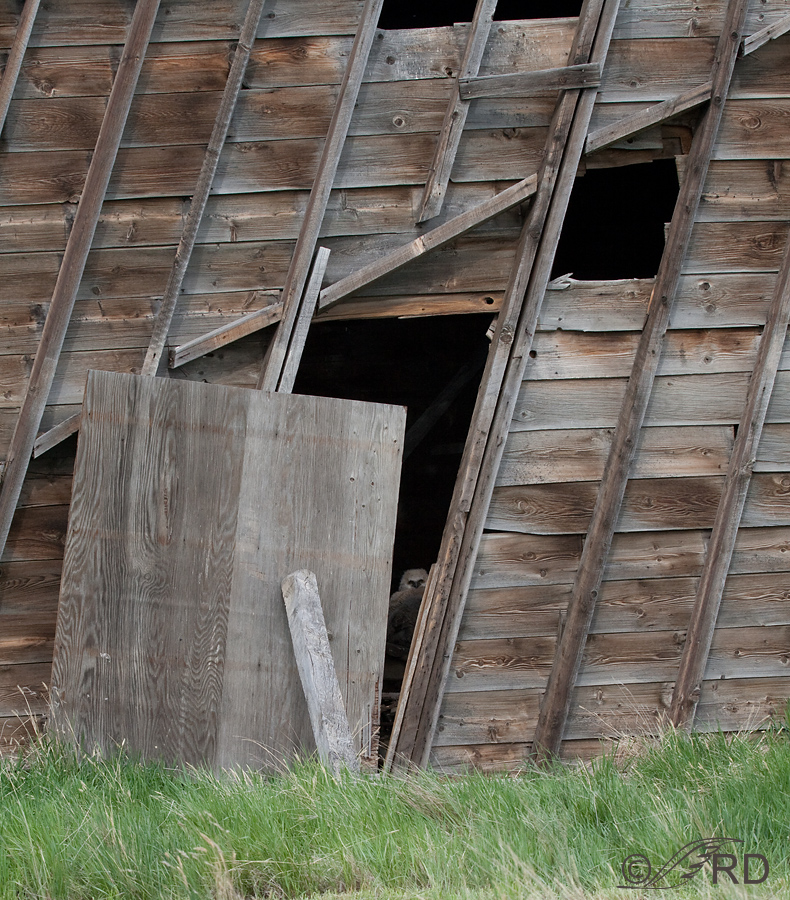
This granary was always called “Wayne’s Granary” because when the farm was split up in the early 1940’s my Dad took it over. This granary is one of the owl’s favorite places to nest and raise their chicks. Look carefully and you’ll see one of them peeking out at you from the interior shadows.
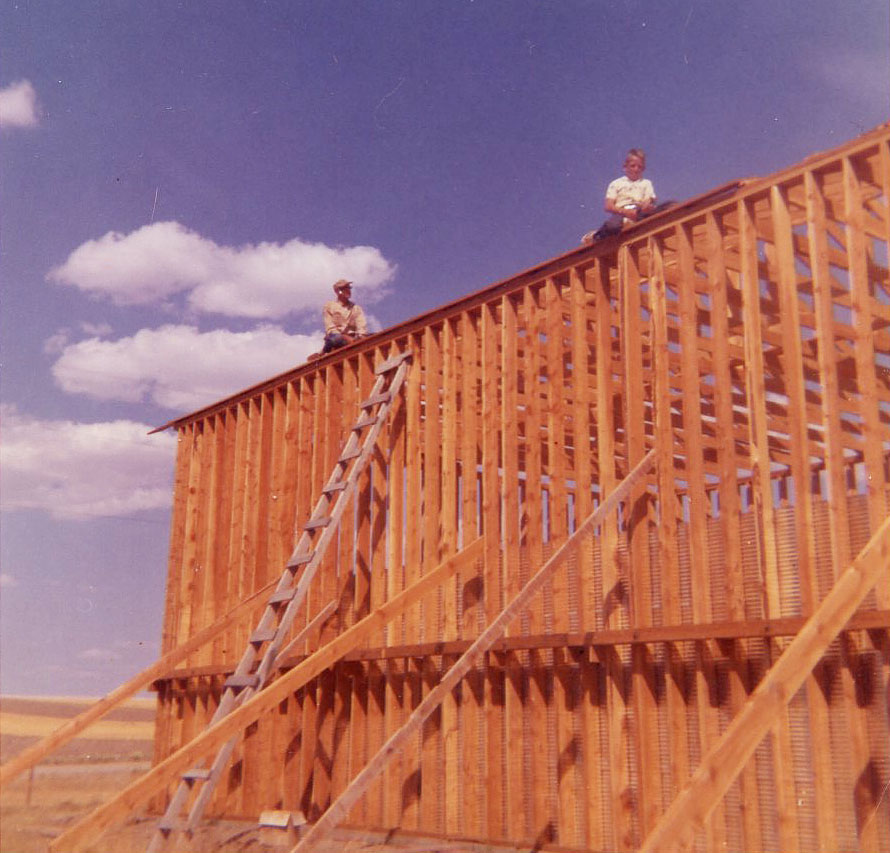
Even yours truly was part of the tradition of building granaries on the farm. Here my Dad and I were building yet another one in about 1957 when I was ten years old. The construction techniques we used were very similar to those of my grandpa Dudley and my Uncle Floyd.
To this day I remember how terrifying it was to work on the edge of the roof and especially making the transition from that rickety old wooden ladder to the roof. And coming down was even worse, especially that first step onto the ladder. And no, in those days we didn’t use any safety gear.
That box we see on the ground was chock full of nails when we started. Nail guns didn’t exist back then. Damn we did a lot of pounding – it’s no wonder my right arm is bigger than my left.
My mother took this picture and she was almost as terrified for me as I was but I tried not to show my fear. I thought I was tough…
- Note: As a photographer I can’t help but notice the small contrail in the sky, even back in 1957 over relatively remote northwest Montana.

Beginning in the early 1970’s wooden granaries were no longer built on the farm. Instead metal granaries and grain bins were used. Here we see a cluster of them just east of the main farmhouse at sunrise. At the left of the photo is a single older wooden granary and a metal quonset. A grain auger sits to the right of the metal bins.
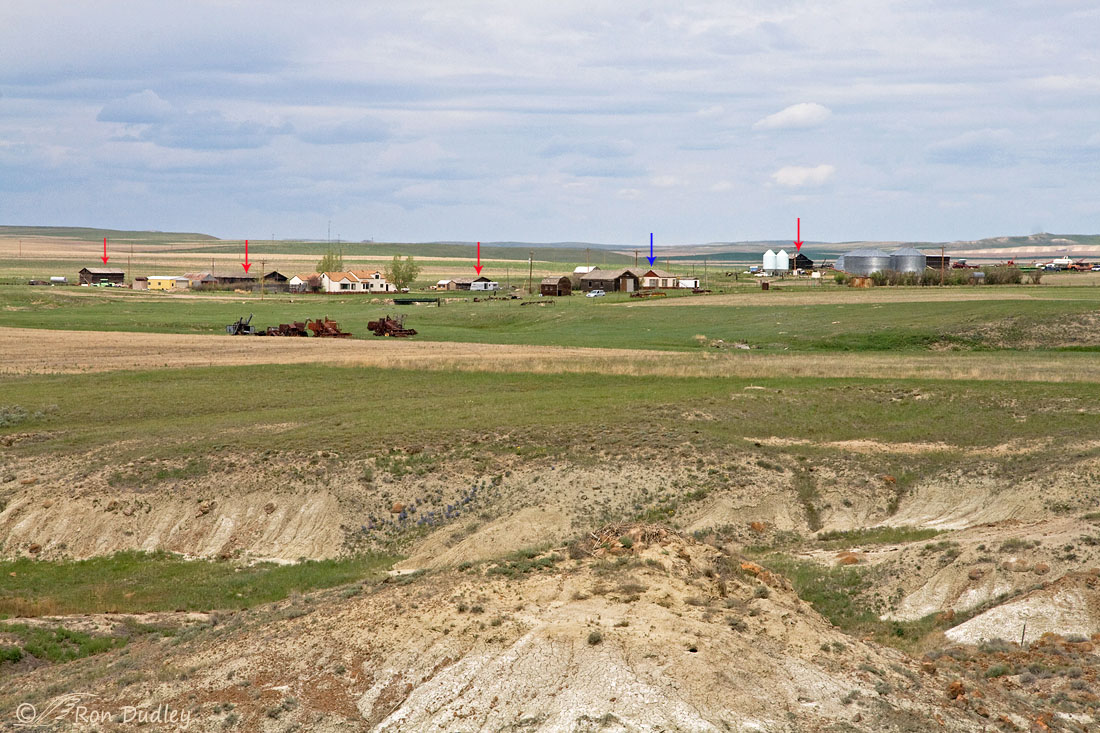
In this view of the combined farms taken from the southeast I’ve marked some of the old granaries with red arrows. I grew up in the house marked by the blue arrow. The “big granary” is indicated by the second red arrow from the left and the granary on the hill that eventually blew down is marked by the far right arrow.
There’s a raptor nest, Ferruginous Hawk if I remember correctly, at the peak of the cone shaped mound in the foreground.
I got carried away with this post. My original intention was to post only two photos but when the farm and my family history are involved I tend to expound perhaps a little too much. Especially when owls are part of the story.
Now I’ve got to finish my taxes. Good hell, Ron – talk about procrastination. It’s April 15th!
Ron


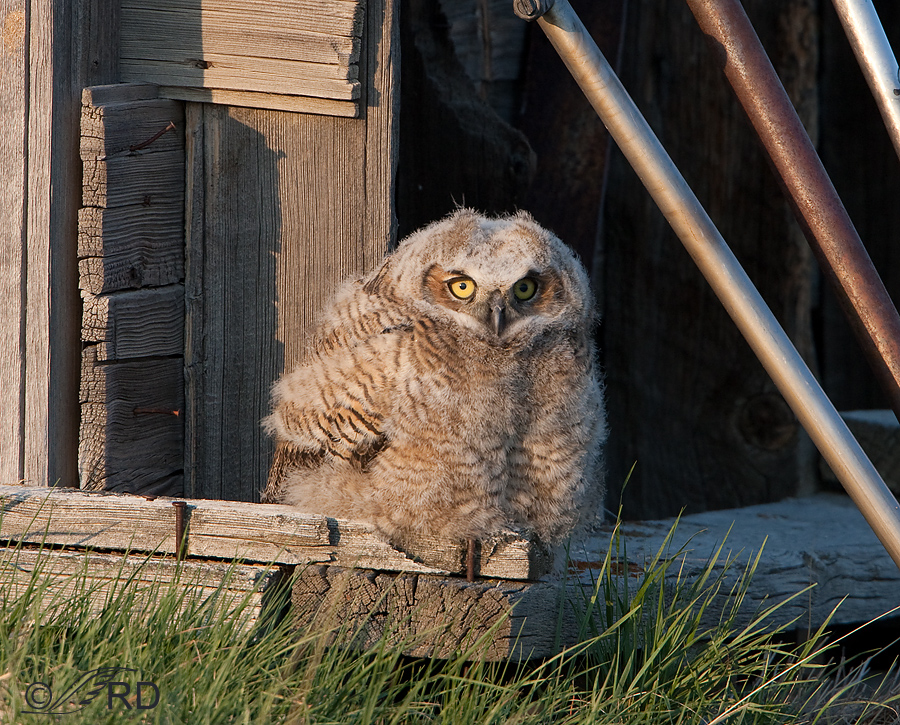
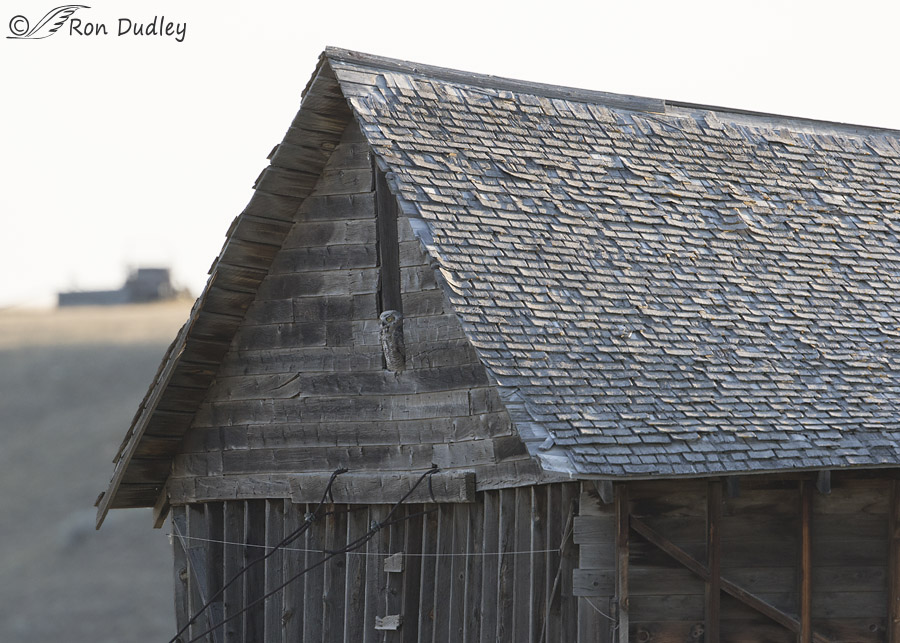
LOVE this post, Ron! I always wondered about this property since you “teased” it so much in your owl photos and other stories. Fun to learn about your childhood and roots.
Ron, I love this series of photos and stories of your childhood and farm experiences. I hope when all the old granaries are gone the owls will find new nesting spots around the farm.
Didn’t get to read this tonight, as my day was chock full! A little unusual in these times. But I, too, enjoy your occasional dips into family and farm history. The photos of the owls in the abandoned granary show something very typical of their behavior. In parts of eastern Colorado, many abandoned buildings with broken windows or holes in the structure have an owl family.
I’m amazed by the small detail you notice, like the contrail in the sky in the picture of you working with your Dad on the granary. I had to look several times before finding it.
Nancy, I remember that at about the time that photo was taken on those fairly rare occasions when we would actually find a contrail we were amazed and even slightly delighted because they were so rare. It was like finding a jewel in the sky.
Now I find them unpleasant and disturbing.
Great photos, great history, great childhood and a wonderful place to grow up. No one learns how to work harder and earlier then farm raised kids. Thanks for the photo essay.
“No one learns how to work harder and earlier then farm raised kids.”
I think there’s some truth to that, Marshall. We may not like some of it at the time, and I sure grumbled about spending days on end on the tractor, but the experience has served me well over the years. And the memories are mostly wonderful.
Not enough “loves” for today’s post — Dudley history AND my favorite owl species! The little fuzzbutts are too adorable for words!
Even though you’ve nixed the book idea, might I suggest recording some of these memories for Shannon. I have a few DVDs of my grandfather’s story in his own voice that my cousin recorded (on VHS — that’s how long ago) that are truly treasured mementos of mine. I also have a couple of old tapes from the 60s of my dad teaching some outdoor ed lessons up in the mountains. These were recorded by a student teacher and were sent to me about 20 years ago, shortly after Dad died. It was so nice to hear his voice again — and some of his horrible jokes (that’s where I get it from).
It’s something to think about, Marty. I was actually talking with a friend about doing something similar just yesterday.
Many, many thanks.
And then some more.
And yes, I am also smiling at the fudly family history tag.
Thanks, EC.
And WHAT fudly family history tag? I don’t see such a tag…
So something has been messing with my mind again? Which is not hard to do.
I’m joshin’ you, EC. It was there and I fixed it.
Damn! I snoozed; I loozed!
Ron, I really enjoy the family stories you share on this blog. The accompanying photos make them all the more interesting. Have you written a book? If not, you should. You obviously write well and you seem to have collected quite a few family photos. I have helped with some family histories in my family (including some limited help with the book that was written by Ward Roylance) and it is very rewarding. Anyway, just a thought.
Others have suggested the same thing, Brad. I’m afraid there’s no book in my future. I used to use the excuse that I don’t have time but given everything going on right now I’ll just say I don’t have the ambition and leave it at that.
One passes by old farm buildings and wonders about who lived there, what their days were like. You provide a look into those lives. Thanks for that. You/we really are no doubt going a little stir- crazy.
You/we really are no doubt going a little stir- crazy.
I do enjoy whenever you share your photos and experiences of the fudley family history (check your tags)
More than just a little stir crazy, Lyle. And I’m not as confined as some are in other states.
And thanks for the heads up! Fixed.
Thanks for sharing a little more of your family history intertwined with a little owl story here and there !!!
Any news on AI opening ?? Looks like YNP will open in late May.
Nope, nothing new on the island, Gary. It’s open for residents of Davis County but no one else.
Looks like I’m going to have two days to kill on my way up to YNP. Maybe Farmington or Bear River NWP will be open…
Your best bet is Bear River. It’s open now (I was there two days ago) but most of Farmington Bay WMA is always closed this time of year for nesting season.
Being from a small farming town in south eastern Idaho your story brought back memories of my home. Great pictures and wonderful story. Thanks.
Farmers and farm kids share a special bond don’t they, Betty.
What wonderful growing up memories for you. A friend of mine in Pennsylvania has a rickety old barn on her property that houses a black vulture family. Each year it’s a treat for her to watch the family grow and thrive and since she augments their diet, they aren’t at all afraid to visit on her rooftop or even to come down on her patio. Of course, she keeps them wild, but what a blessing!
Thanks, Laura. Those vultures sound like fun!
I love all things about GHO, probably because we have some that reside nearby and visit our yard in the early winter. I was shocked in a good way recently to see that our city has posted two signs near their nest in a park warning visitors not to get too close or linger. What a relief as I feared one day the city would remove their nesting tree since it is long dead but obviously they recognize it is wildlife habitat.
That’s very good news, Linda. As you know all too often those old snags are cut down prematurely.
Loved following you down memory lane Old buildings… owls.. and that beautiful sunset. You were one lucky kid to grow up there
Old buildings… owls.. and that beautiful sunset. You were one lucky kid to grow up there 

Enjoy your day
I’ve always considered myself lucky to grow up there, Diana. And I still love that place half a century later.
The family history was interesting and any morning with owls is always welcome.
Thanks, April.
A really nice story about the barns and your ancestors Ron. And of course the Great Horned Owls who are among my favorite birds. My dad had a grocery and meat market in suburban Philadelphia and when I was a kid he used to take my with him when he would drive out to Lancaster County to buy chickens, eggs, and produce, and I used to love to visit those beautiful farms with the old red barns.
PS: and thanks to the extensions no rush on the taxes.
Thanks, Everett. See my reply to Arwen below regarding the extension.
Old farm/ranch/homestead buildings have such a special, melancholy
beauty–character in every handcut window opening and chinked space–
it’s wonderful that they’re still standing for those generations of owls to
fledge in, hunt, and enjoy the sunsets—-I really enjoyed these lovely
reminiscences—thanks.
Kris, sometimes when I’m on the farm I just stand in front of some of those old granaries and wonder. Things like did my Dad cut that sloppy auger cutout when he was a young teenager? Did my grandpa somehow raise that huge granary wall after it was built all by himself or did he build it in place? The list of things I wonder about is almost endless.
Delightful to read the history, and to see the owls in context.
Thank you, Dan.
I love reading about people’s stories in relation to the pictures! Thank you for sharing.
Good. Thanks, Melani.
What an adventure to see these fantastic pictures of owls and your farm. Really scary perch you had wile building!! Thanks you, Ron!
Mary, to this day I’m more than moderately acrophobic, perhaps because of helping to build that granary and a few others.
What a lovely story and accompanying pictures. Yes I’ve seen the GHOW in the barn photos before, but they never get old. Thank you for sharing.
Thank you, Zaph.
Beautiful pictures…as usual!!!
Where in Montana is this? I spent a long summer up around Garneill. Truly some of the most unforgettable memories of my life. In fact, that was where I saw my first Bald Eagle, sitting in a field. I couldn’t believe how huge it was! Anyway, thanks for sharing your beautiful photos and memories…
Sheila, the farm is 17 miles northwest of Cut Bank MT, about 50 miles east of Glacier NP and about 30 miles south of the Alberta border (on roads, not as the crow flies).
Wonderful set of photo’s of the Owls and the granaries! LOT of work and lumber went into those – still have one small one here. This one fairly protected so the wind hasn’t taken it yet…. Definite “yawn” when they’re feeling threatened the fluff up and wings spread leave no question about it!
LOT of work and lumber went into those – still have one small one here. This one fairly protected so the wind hasn’t taken it yet…. Definite “yawn” when they’re feeling threatened the fluff up and wings spread leave no question about it!  it’s snowing/blowing again here tho “warmer”
it’s snowing/blowing again here tho “warmer”
Judy, for those first few granaries my grandpa Dudley had to haul all the lumber from across the mountains near the Kalispell area. He used a 1929 Ford grain truck to haul it so it took many trips and he really had some stories to tell about some of them.
I’m sure! Did what they had to do………..
Really enjoyed this series. AND? I’m really enjoying that we don’t have to file taxes until June.
Arwen, If I miss this traditional deadline I know me – I’ll put it off to the last minute again.
Thank you Ron for this lovely photo essay. What a great history you have!
I’m glad you enjoyed it, Gail. Thank you.